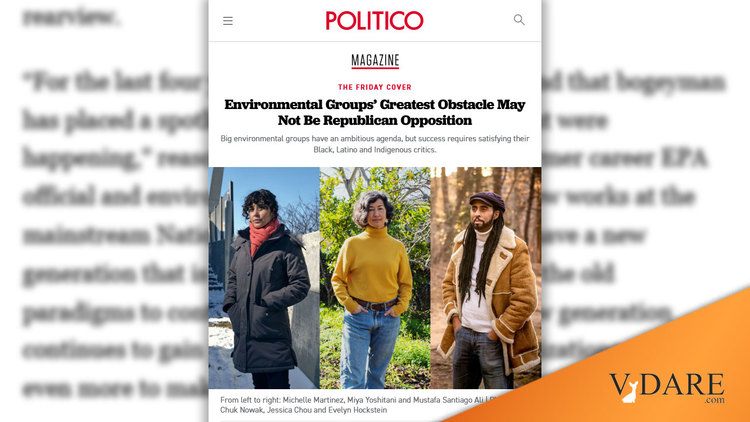
Coalition Of The Margins Threatens Biden’s Green Agenda
By Steve Sailer
02/05/2021
From Politico:
Environmental Groups’ Greatest Obstacle May Not Be Republican Opposition
Big environmental groups have an ambitious agenda, but success requires satisfying their Black, Latino and Indigenous critics.
By ZACK COLMAN
02/05/2021 04:30 AM EST
Updated: 02/05/2021 03:37 PM EST
Zack Colman is a climate and energy reporter at POLITICO.
When the leaders of the “Big Green” environmental groups realized last fall that they’d be confronting, at best, a closely divided House and Senate with only a wavering appetite for carbon restrictions, they knew President-elect Joe Biden would need an all-star EPA chief with the savvy necessary to use existing laws to lead the fight against climate change.
He needed Mary Nichols.
The California air cop had engineered secret climate deals with major automakers, infuriating President Donald Trump. Her command over the Golden State’s environmental rules gave her unparalleled clout within the movement. She implemented one of the country’s largest greenhouse gas emissions trading schemes to blunt global warming.
But the environmental organizations that quietly backed Nichols and allies like Senate Majority Leader Chuck Schumer who publicly promoted her did not anticipate the backlash she would ignite within Black, Latino and Indigenous communities. Complaints that Nichols had failed to adequately address local pollution concerns in urban neighborhoods in California derailed her candidacy to lead the Environmental Protection Agency. Biden ultimately nominated Michael Regan, a North Carolina environmental regulator, who is Black and has scored victories for communities in a state considered the birthplace of environmental justice.
Environmental influence in U.S. politics is ascendant. Big Green groups have pushed Biden, whom most would never confuse with a crunchy activist, into crafting the most aggressive environmental platform in the nation’s history that calls for spending $2 trillion.
But as the Nichols saga proved, their greatest obstacle may not be Republican opposition: Would-be allies within the Black, Latino and Indigenous communities are disaffected by an agenda that many see as focused on save-the-planet idealism at the expense of the nuts-and-bolts concerns of their communities, from elevated asthma rates in pollution-clogged urban communities to safeguarding traditions on Indian lands.
“The grassroots environmental justice community has tentacles in communities all across the country,” said Cecilia Martinez, a longtime environmental justice organizer who now heads that portfolio at Biden’s White House Council on Environmental Quality. “They’re not shy about stepping up and asking for involvement, and we have to make sure that we make those spaces and hear them out.”
The crucial backdrop for these tensions is the history of white-male domination of the Big Green groups, which have just 22 percent non-white senior staff in a nation that is about 40 percent non-white. In addition, at the very moment they see an opportunity to advance their policy agendas, many large, mainstream environmental organizations are facing internal reckonings over race and gender equity.
In 2019, POLITICO revealed a culture of gender discrimination, sexual harassment and racial disparities at The Nature Conservancy that led to the departure of its top two officials. E&E News last year reported on a “traumatic” culture on race within the Union of Concerned Scientists. POLITICO in November uncovered persistent racial inequity at the National Audubon Society, where staff accused CEO David Yarnold of overseeing a workplace rife with intimidation and threats.
The internal convulsions and the external tensions appear to have sent a message that environmental leaders can’t ignore: the only way to fashion their movement into a formidable political force is by becoming more Black and brown. That requires expanding beyond a purely ecological agenda and zeroing in on issues that highlight racial and social inequalities.
In other words, cutting “Black and brown” activists in on more deals. Cash on the barrelhead. There is, of course, plenty of money available by raising the cost of energy.
But one obvious issue is that environmental issues tend to be intellectually complex. So will lower-brow non-white activists be happy to go along with the ride in return for payoffs? Or will their megalomania induce them to demand real power in situations where they are in over their heads? Will energy companies buy off greedy and stupid non-white Environmental Justice entrepreneurs?
In any case, we can be sure that the more white greens and black grifters fight, the more denunciations of White Male Devils for destroying the planet will be forthcoming.
